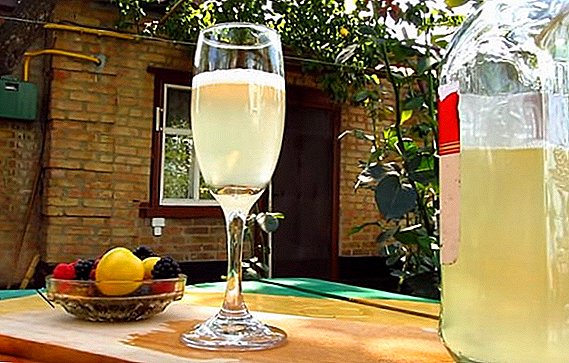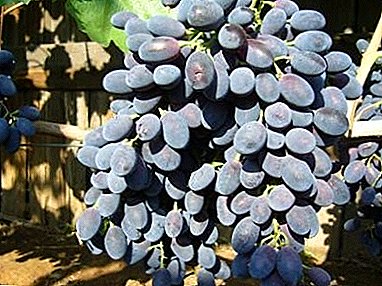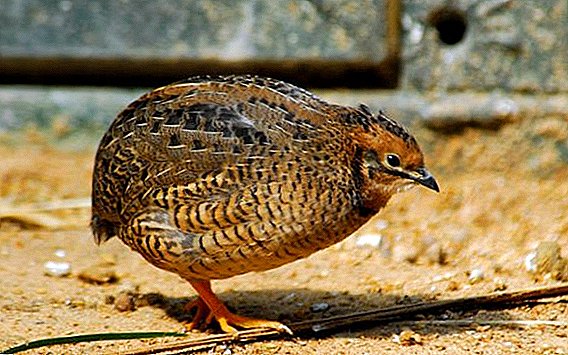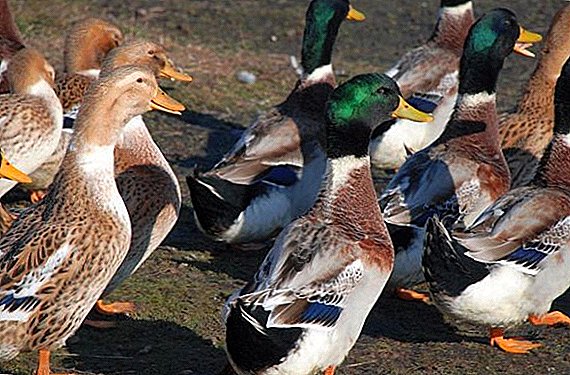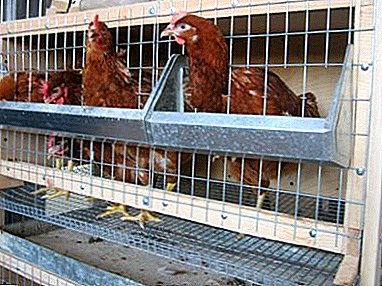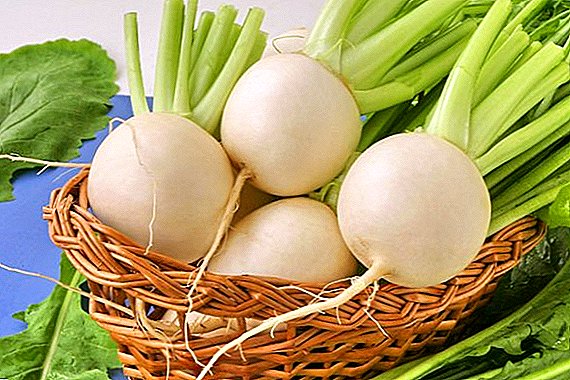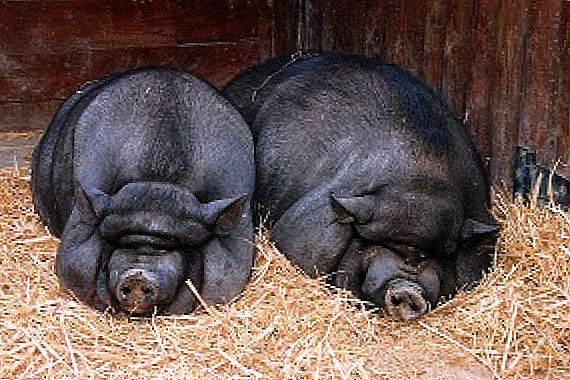 Vietnamese pigs are beginning to become more and more popular lately. In our country, breeding such a breed began relatively recently, but, despite this, there are already many conflicting rumors. Correctly called this breed Asian or Vietnamese vislobryushaya pig.
Vietnamese pigs are beginning to become more and more popular lately. In our country, breeding such a breed began relatively recently, but, despite this, there are already many conflicting rumors. Correctly called this breed Asian or Vietnamese vislobryushaya pig.
This is the name she received from a saggy belly. What other interesting factors this breed possesses, as well as the pros and cons, you will read in this article.
The history of the development of the Vietnamese breed of pigs
 The Vietnamese breed was bred in Southeast Asia, because of this, it would be correct to call this breed an Asian herbivorous oil-sprouting pig. In Canada and several European countries, the breed was brought from Vietnam in 1985, because of this, they are called Vietnamese pigs.
The Vietnamese breed was bred in Southeast Asia, because of this, it would be correct to call this breed an Asian herbivorous oil-sprouting pig. In Canada and several European countries, the breed was brought from Vietnam in 1985, because of this, they are called Vietnamese pigs.
Almost immediately, this breed found its fans and was further developed and popular all over the world. Scientists have set the goal of improving productive indicators, increasing the size and percentage of muscle mass. What is being done today.
In Ukraine, the breed appeared quite recently. And immediately the farmers began to compare them with other breeds with which they found similarities: Korean and Chinese breeds. The Korean breed is the same Vietnamese breed, it just got such a popular name. But the Chinese are called decorative dwarf pigs, which have the roots of Vietnamese pigs.
Positive aspects and features of Vietnamese pigs
This breed of pigs has features that distinguish it from others. These features must be considered when breeding, keeping and caring for the breed. Many of these traits can be attributed to the positive qualities of the Vietnamese pigs, because of which this breed is so famous and popular.
Features and positive qualities of the breed:
 This breed belongs to the early maturing pigs. Many farmers are concerned about such a question, at what age puberty occurs in the pigs of this breed? Vietnamese females reach puberty as early as four months and are able to give birth to offspring. In Vietnamese males, puberty occurs later by six months.
This breed belongs to the early maturing pigs. Many farmers are concerned about such a question, at what age puberty occurs in the pigs of this breed? Vietnamese females reach puberty as early as four months and are able to give birth to offspring. In Vietnamese males, puberty occurs later by six months.
It is very easy to care for newly born piglets and keep them simple. Sows have a very well developed maternal feeling, and this factor facilitates the work of the farmer.
Vietnamese pig breeds have very good immunity, because of which they very quickly get used to different weather conditions. Even if the homeland of these pigs is in the hot tropical region, but this does not prevent them from growing well and developing in colder countries.
The meat quality of the Vietnamese breed is very high, the meat is tender and juicy, and is considered a delicacy. The thickness of fat and lard usually makes up two or three fingers, and as well as the meat is very tasty. The carcass of a Vietnamese pig is cut into two half carcasses.
The Vietnamese breed of pigs is very rarely exposed to ordinary pork diseases, which means that it is not necessary to vaccinate them from some rare diseases. One unpleasant event in their breeding can be worms. But here it is impossible to fully protect your wards from worms, so it is simply necessary to carry out preventive measures.
 Vietnamese sows are very prolific. For one litter, she can bring up to eighteen pigs, but about twelve piglets are more frequent. On average, up to 24 piglets can be expected per year.
Vietnamese sows are very prolific. For one litter, she can bring up to eighteen pigs, but about twelve piglets are more frequent. On average, up to 24 piglets can be expected per year.
The Vietnamese pig breed has a very well-developed genetic memory, which protects them from eating various poisonous herbs.
In the case of the swine pigs, the diet is quite frequent, but small. Basically, their food consists of green fodder, so they are popularly called Vietnamese herbivorous pigs.
But it's silly to think that this breed feeds only on pastures.
The positive side of the Vietnamese breed is their cleanliness, they immediately see the difference between the toilet and the bedroom. This arrangement is a big plus, because it makes it easier for the farmer to clean and clean the barn.
How much all the listed positive aspects of this breed will develop depends on the young that you buy for rearing and feeding. It is also very important what kind of accommodation, care, food you provide for your pigs. Let's try to understand together how to get the best results when fattening and growing Vietnamese pig breeds in a household.
There are practically no flaws in this breed of pigs, It is necessary to protect animals from cold and feed them with suitable feeds. Rough feeds are poorly digested, but whole grains are not digested at all. By the minus can be attributed, and the strong concern of sows to their babies.
Characteristics of the appearance of the Vietnamese pigs
Vietnamese pigs can be very well distinguished from other breeds, so you will have no problems buying these pigs.
External signs of Vietnamese pigs:
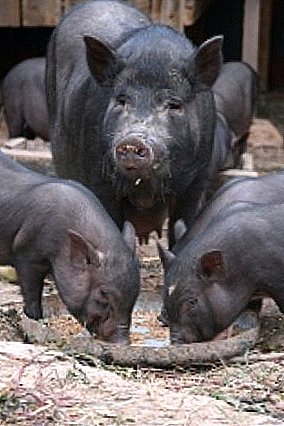 Slack belly - even a small piglet has a saggy tummy, and already in adult pigs the belly almost always reaches the ground.
Slack belly - even a small piglet has a saggy tummy, and already in adult pigs the belly almost always reaches the ground.- The color of this breed is black, but it can be of different shades.
- The pig muzzle is slightly flattened.
- The chest and back are wide enough.
- The legs of the Vietnamese pigs are short, which makes the breed squat.
- The ears of pigs are erect, small.
- Boars differ characteristic bristles.
- Adult pigs can reach a weight of up to eighty kilograms, and with a longer maintenance, breeding pigs can reach up to 150 kilograms.
Features that you should pay attention to when buying Vietnamese piglets
There are two ways that a farmer can breed Vietnamese piglets, either to buy young stock for breeding, or to buy and feed pigs:
 In both cases, you must apply for the purchase of pigs to reliable vendors.
In both cases, you must apply for the purchase of pigs to reliable vendors.
If you are going to breed piglets with tribes you do not need to buy them from one seller, it is better from several. This should be done in order to avoid a kindred cross.
Do not hesitate to ask the seller about the weight of pigs at birth, as well as about the weight gain for a certain period of time. If you know this, you can imagine the initial weight of the pig.
You can even need to ask the seller to show the parents of the pigs. If the seller says that the piglet is one month old and its weight is no more than 3.5 kilograms, then its mother’s sagging nipples should be visible, and she herself should be thinner. If you see inconsistencies, you will make sure that you are trying to sell an older pig, or maybe that you were shown to another mother, which speaks of an unscrupulous seller.
You also need to ask you to show a few pigs. By external characteristics, you can understand what the pig will be in the future. Healthy Vietnamese piglets have sufficiently developed musculature, the limbs are strong and widely set. The head of the piglets is broad and the curves of the nasal bones should be clearly visible. The fact that the piglet is healthy, says even coat, the body is elastic, the tail under which is clean and dry, the eyes shine, moves well and eats.
It is necessary to ask the seller about what feed the piglet ate. It is necessary to quietly change the composition of the pig.
Vietnamese piglets grow fast enough and are suitable for slaughter at the age of three months, which will ensure your family table is always high-quality, young and succulent meat. But it is best to fatten them up to seven months, this age is the best for slaughter.
Vietnamese piglet content
Before you start to grow Vietnamese piglets, you must first prepare a room for them to keep it. This breed of pig is not whimsical to the conditions of detention and any special care. So the breed of pigs is not too big, it will allow you to turn a small shed into a very real farm.
So, a few points on the content of the Vietnamese breed:
- If you plan for a long breeding of these pigs, it is best to prepare for them a comfortable and convenient room. A shed can be built with gas silicate blocks or bricks.
- The floor is best to make concrete, you will be much easier to clean. Part of the floor of the pigsty must be covered with wood. Wood flooring will be for the bedroom of pigs and animals will be warmer in winter. A concrete floor will not allow pigs to rummage.
- The entire shed must be divided by partitions, either wooden or iron. The area of one such pen should be up to five meters square. In one pen fit two adult pigs, or a sow and piglets.
- You also need to allocate a place for the corridor so that you can easily transport the cart for cleaning manure.
- The shed in which the animals will be kept must have good ventilation. If there is no fresh air in the room, or there are drafts, this will adversely affect their health.
- Despite the fact that the Vietnamese pigs are accustomed to low temperatures, but in winter it is still necessary to warm the room. In the winter, most of all you should pay attention to newborn piglets and sows. Low temperatures can affect their health. You can heat the barn in different ways, it can be a Russian stove, rough, gas heating or in any way available to you.
- If you are going to engage in breeding Vietnamese breed of pigs, you should know that they need to organize walking in the warm season. To do this, you need to separate the territory with the calculation of one adult pig per one hundred parts. A separate walking area should be made for vislobryushek. On the territory of walking it is necessary to dig a few logs into the ground, for scratching the back.
- It is necessary to make a canopy over the territory of walking, so that animals can hide from the sun and rain. If you succeed, you can make a mud pool for animals, for which the mumps will be very grateful. This pool will help the pigs to cool off in hot weather, as well as get rid of annoying insects.
What to feed Vietnamese pigs?
There are a very large number of different recipes for feeding pigs in winter and summer, which contradict each other. On the Internet you can read that pigs can be fattened only with grass and pastures. But such animal nutrition will not give the desired result for you, and the mass of animals will be small. Let's all the same figure out how best to grow Vietnamese pigs at no extra cost, but with the maximum weight.
 Before you begin the process of fattening, you need to think about the possibility of cheaper feed. It is impossible to talk about increasing the profitability of pig breeding when feeding animals at home only purchased feed. Therefore, you need to find a way out to grow crops yourself, or buy them from proven vendors, in such quantities as to provide all of your home stock.
Before you begin the process of fattening, you need to think about the possibility of cheaper feed. It is impossible to talk about increasing the profitability of pig breeding when feeding animals at home only purchased feed. Therefore, you need to find a way out to grow crops yourself, or buy them from proven vendors, in such quantities as to provide all of your home stock.
In order to reduce your expenses on the purchase of feed, you need to learn how to prepare high-calorie feed that is suitable for feeding Vietnamese pigs. The daily ration of animals should always be fresh, properly balanced and of good quality. Observing all the requirements you can achieve good results, that is, a good weight gain in pigs.
As we mentioned earlier, The summer diet of Vietnamese pigs consists of green fodder.. According to the structure, the digestive tract of Vietnamese visually bruised gilts is slightly different from all ordinary breeds (the stomach is smaller in size, slightly smaller than the diameter of the intestine, the increased rate of passage of food through the tract and many other features). All these indicators affect the degree of digestion of incoming food. It is better not to feed vislobryukh pigs with roughage, food containing large amounts of fiber, fodder beet, straw, etc. Pigs will not give up green grass, hay from alfalfa and clover.
But in the diet of animals should also come grain crops - wheat, barley, rye. In the process of feeding pigs do not need to get involved in oats and corn, because it contributes to an increase in fat in their body.
Grain feed can be given in the following ratio:
- Barley to 40%.
- Wheat up to 30%.
- Oats up to 10%.
- Pea to 10%.
- Corn up to 10%.
Grains need to grind and mix in a suitable quantity, whole grains are not digested and then everything is removed with feces. It was observed that the fat and meat of Vietnamese pigs are better in taste when fed them wet food. To do this, mix a portion of concentrated feed (about four liters) with half a teaspoon of salt, pour all this with boiling water (about nine liters of water) and let this mixture stand for about twelve hours. Before issuing the mumps mixture there, you need to add vitamins and fish oil. One bucket of such feed will feed three sows on one of two feedings.
Lactating sows, as well as pregnant women, add eggs, milk products, vitamins and whey to the mix very well. The piglets that you fatten must be given one and a half buckets of the mixture to ten individuals, they are fed twice a day.
Another option for feeding animals is feeding them to cooked thick porridge from feed. Such food is chewed on for a long time by pigs, which causes abundant salivation, as well as faster transformation of starch into sugar. All this affects the good absorption of nutrients and faster digestion of food.
Vitamin feeds, especially those that are well preserved in winter, also affect the weight gain of pigs. These are zucchini, pumpkins, carrots, vitamin hay from legumes. All these cultures must be given to the pigs raw. The heat treatment of these vegetables destroys all the beneficial vitamins that are very useful for animals. As a high-calorie diet, boiled potatoes can be given to animals. Potatoes need to be given in the amount of 15% of the total feed, but when adding potatoes, you need to remove that amount of flour or feed.
It must be remembered that your players increased their weight, you need to follow all the recommendations on nutrition. If there is any error in the diet, there may be a failure in your small business.
How to breed Vietnamese pigs?
 In order to get healthy, productive and viable offspring, it is very important to keep in mind one key rule in this matter - that the pig and the boar are not related.
In order to get healthy, productive and viable offspring, it is very important to keep in mind one key rule in this matter - that the pig and the boar are not related.
The Vietnamese breed belongs to the early maturation, but it is not necessary to happen to a pig if it weighs less than thirty kilograms, because it will badly affect its health, and the health of future babies.
In order to understand when an animal is ready for mating, attention should be paid to the following factors:
Pigs are becoming restless.
The sexual loop swells up.
There may be a selection.
If you push the croup of the Vietnamese pig a little, then it stops and listens, does not leave the place.
For mating, the female and male are planted in one pen a day.
The gestation period of this breed of pigs varies from 114 days to 118. Approximately five days before the birth, the pig becomes restless, makes a nest, chews, and crushes hay. During this period, milk lobes begin to form, swollen nipples turn red, and the stomach begins to fall. On the day when litter will occur, the pig refuses to eat, and droplets of colostrum begin to stand out from the nipples.
For this crucial moment, you need to prepare in advance: clean the machine and put fresh hay, pour clean and fresh water into the trough. In addition, you need to allocate a corner for piglets, to make heating in that place, because for the first time newborn piglets need air temperature from 30 to 32 degrees. It is necessary to prepare diapers for wiping piglets, scissors and thread for tying the umbilical cord, iodine solution and cotton wool.
Some livestock breeders prefer not to interfere in this process, but it is best to start caring for newborn piglets earlier. For babies born, the supply of nutrients is small, and the colostrum in the first hours may not appear, which can be disastrous for them. Each piglet needs care, you need to clear them of mucus, release airways, bandage and trim the umbilical cord, process it with iodine.
The polling time varies from three to five hours; at the end of this process, the afterbirth comes out, consisting of two parts. All parts must be assembled so that the sow does not eat it.
How to care for newborn piglets:
Each of them should eat mother's milk. Первые несколько дней они сосут маму через 30-40 минут, нужно следить за тем, чтобы каждый их них хорошо ел. При питании поросят только молоком, в их организме снижается железо, что в следствии может привести к плохим последствиям.Therefore, each piglet must be given an intramuscular injection of an iron preparation.
The right thing to do would be to have a registration card for each piglet in order to record all the features of growth and development.
Weaning piglets from mom need not immediately, but gradually. This is done so that the mother does not develop mastitis, and the piglets do not feel worse. At the age of forty, babies can be given prophylactic vaccines against worms.
How to protect the baby from the disease?
Since the birthplace of the animal is Asia, there are such diseases that are unknown to us, it must be concluded that the pigs have good and stable immunity. This breed can even distinguish poisonous herbs.
Vietnamese pigs are sick most often where there is a lot of infection and stay in a dirty room.
But preventive measures will not hurt anywhere. Newborn piglets need to be vaccinated at the age of one day. Also then do helminth vaccinations.
Also worth getting vaccinated for salmonellosis. This disease is infectious, suffers from the gastrointestinal tract. The reason for his mouse and rats in the barn.
Another disease is erysipelas. Pink, red, blue spots appear on the body of the pig. After a couple of days, the mumps refuse food and almost all the time lies. They tolerate the disease of birds, mice, flies. The disease enters the body of the animal through water and food. Therefore, it is necessary to keep everything clean and avoid contact of pigs with disease vectors.
This breed may suffer from depression, due to poor care for them.
With good care and maintenance of animals, they will not bring you any trouble.
The occupation of pig breeding, in particular the breeding of the Vietnamese breed, can be an excellent income for the farmer. But to achieve this, you must first plan everything, and then follow all the instructions. Only with the observance of all the necessary rules you will achieve results in this matter.


 Slack belly - even a small piglet has a saggy tummy, and already in adult pigs the belly almost always reaches the ground.
Slack belly - even a small piglet has a saggy tummy, and already in adult pigs the belly almost always reaches the ground.